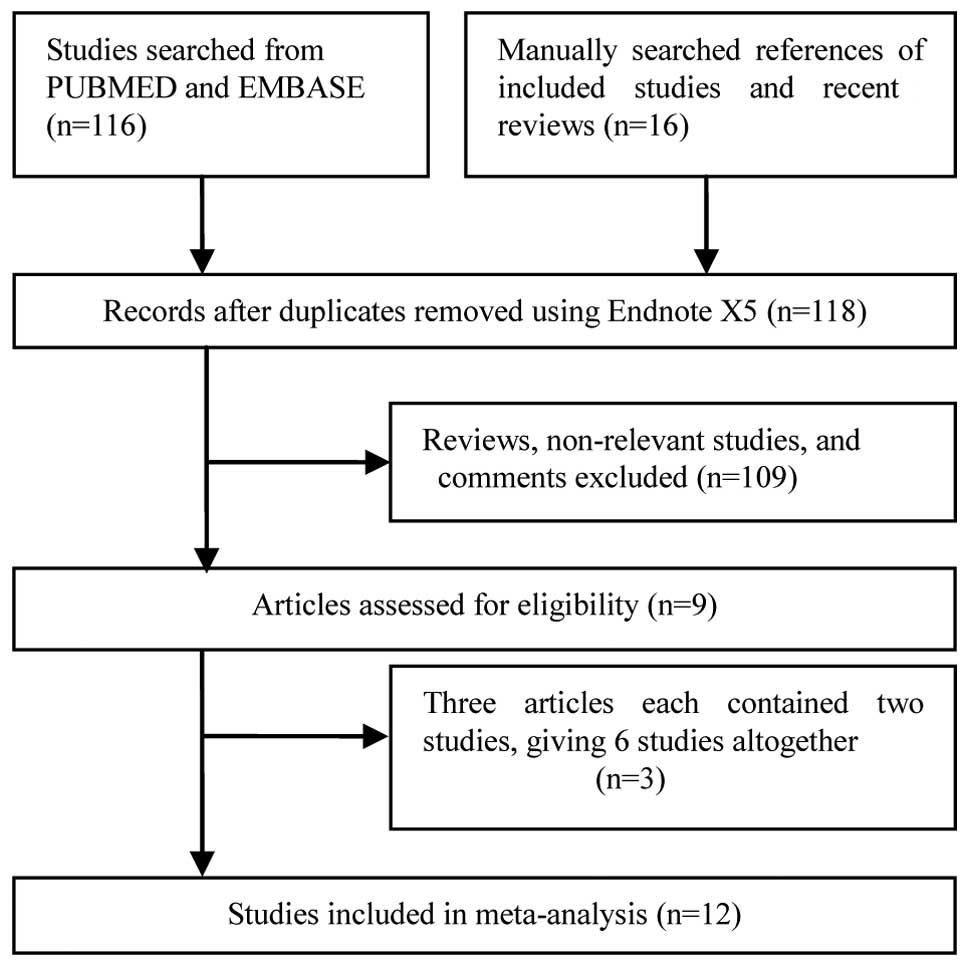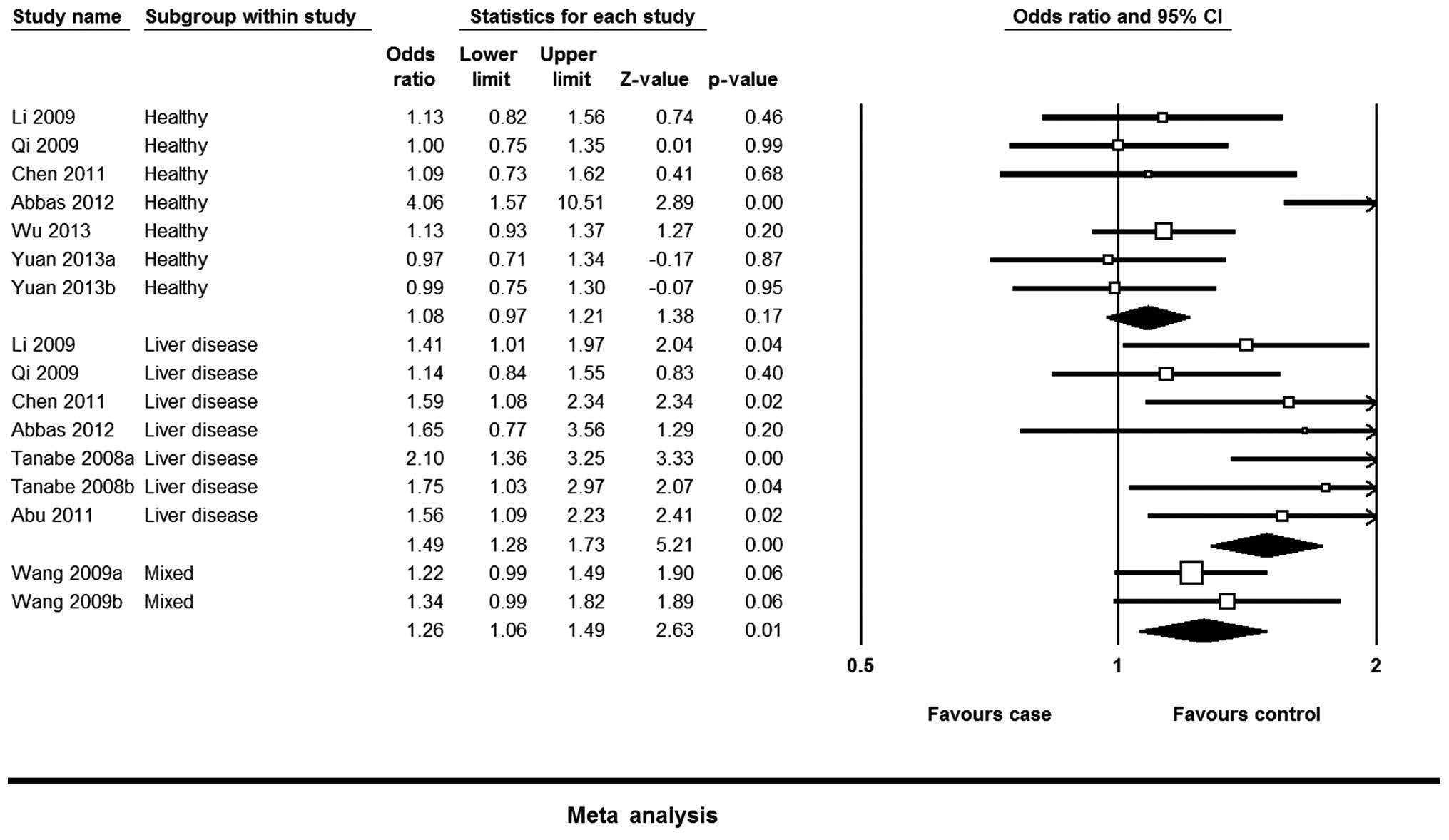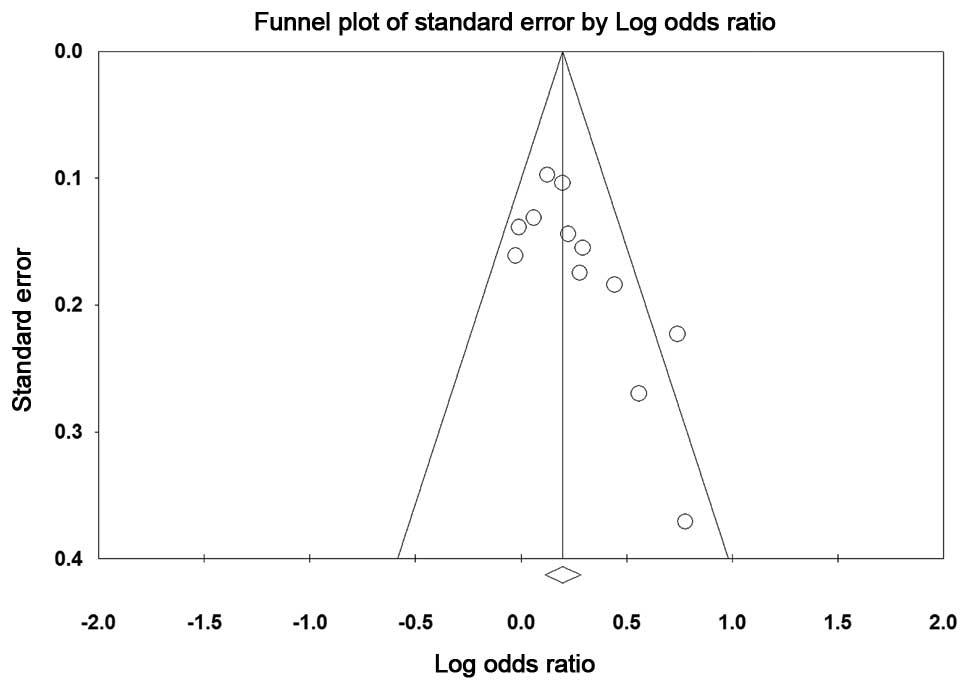|
1
|
Jemal A, Bray F, Center MM, Ferlay J, Ward
E and Forman D: Global cancer statistics. CA Cancer J Clin.
61:69–90. 2011. View Article : Google Scholar : PubMed/NCBI
|
|
2
|
Di Costanzo GG: Prospective analysis of
risk factors for hepatocellular carcinoma on patients with
cirrhosis. Hepatology. 38:10612003. View Article : Google Scholar : PubMed/NCBI
|
|
3
|
Thomas MB and Zhu AX: Hepatocellular
carcinoma: the need for progress. J Clin Oncol. 23:2892–2899. 2005.
View Article : Google Scholar : PubMed/NCBI
|
|
4
|
Caldwell SH, Crespo DM, Kang HS and
Al-Osaimi AM: Obesity and hepatocellular carcinoma.
Gastroenterology. 127(Suppl 1): S97–S103. 2004. View Article : Google Scholar : PubMed/NCBI
|
|
5
|
Yuan JM, Govindarajan S, Arakawa K and Yu
MC: Synergism of alcohol, diabetes, and viral hepatitis on the risk
of hepatocellular carcinoma in blacks and whites in the U.S.
Cancer. 101:1009–1017. 2004. View Article : Google Scholar : PubMed/NCBI
|
|
6
|
El-Serag HB, Marrero JA, Rudolph L and
Reddy KR: Diagnosis and treatment of hepatocellular carcinoma.
Gastroenterology. 134:1752–1763. 2008. View Article : Google Scholar : PubMed/NCBI
|
|
7
|
Trevisani F, D'Intino PE, Morselli-Labate
AM, et al: Serum alpha-fetoprotein for diagnosis of hepatocellular
carcinoma in patients with chronic liver disease: Influence of
HBsAg and anti-HCV status. J Hepatol. 34:570–575. 2001. View Article : Google Scholar : PubMed/NCBI
|
|
8
|
Bolondi L, Sofia S, Siringo S, et al:
Surveillance programme of cirrhotic patients for early diagnosis
and treatment of hepatocellular carcinoma: A cost effectiveness
analysis. Gut. 48:251–259. 2001. View Article : Google Scholar : PubMed/NCBI
|
|
9
|
Kim CK, Lim JH and Lee WJ: Detection of
hepatocellular carcinomas and dysplastic nodules in cirrhotic
liver: accuracy of ultrasonography in transplant patients. J
Ultrasound Med. 20:99–104. 2001.PubMed/NCBI
|
|
10
|
Cohen S: Isolation of a mouse submaxillary
gland protein accelerating incisor eruption and eyelid opening in
the new-born animal. J Biol Chem. 237:1555–1562. 1962.PubMed/NCBI
|
|
11
|
Michalopoulos GK and DeFrances MC: Liver
regeneration. Science. 276:60–66. 1997. View Article : Google Scholar : PubMed/NCBI
|
|
12
|
Zhang YM, Cao C and Liang K: Genetic
polymorphism of epidermal growth factor 61A>G and cancer risk: a
meta-analysis. Cancer Epidemiol. 34:150–156. 2010. View Article : Google Scholar : PubMed/NCBI
|
|
13
|
Lanuti M, Liu G, Goodwin JM, et al: A
functional epidermal growth factor (EGF) polymorphism, EGF serum
levels and esophageal adenocarcinoma risk and outcome. Clin Cancer
Res. 14:3216–3222. 2008. View Article : Google Scholar : PubMed/NCBI
|
|
14
|
Spindler KL, Nielsen JN, Ornskov D,
Brandslund I and Jakobsen A: Epidermal growth factor (EGF) A61G
polymorphism and EGF gene expression in normal colon tissue from
patients with colorectal cancer. Acta Oncol. 46:1113–1117. 2007.
View Article : Google Scholar : PubMed/NCBI
|
|
15
|
Zhong JH, You XM, Gong WF, et al:
Epidermal growth factor gene polymorphism and risk of
hepatocellular carcinoma: a meta-analysis. PLoS One. 7:e321592012.
View Article : Google Scholar : PubMed/NCBI
|
|
16
|
Yang Z, Wu Q, Shi Y, Nie Y, Wu K and Fan
D: Epidermal growth factor 61A>G polymorphism is associated with
risk of hepatocellular carcinoma: A meta-analysis. Genet Test Mol
Biomarkers. 16:1086–1091. 2012. View Article : Google Scholar : PubMed/NCBI
|
|
17
|
Li TF, Ren KW and Liu PF: Meta-analysis of
epidermal growth factor polymorphisms and cancer risk: Involving
9,779 cases and 15,932 controls. DNA Cell Biol. 31:568–574. 2012.
View Article : Google Scholar : PubMed/NCBI
|
|
18
|
Moher D, Liberati A, Tetzlaff J and Altman
DG: PRISMA Group: Preferred reporting items for systematic reviews
and meta-analyses: The PRISMA statement. Ann Intern Med.
151:264–269. 2009. View Article : Google Scholar : PubMed/NCBI
|
|
19
|
Coory MD: Comment on: Heterogeneity in
meta-analysis should be expected and appropriately quantified. Int
J Epidemiol. 39:932–933. 2010. View Article : Google Scholar : PubMed/NCBI
|
|
20
|
Egger M, Smith Davey G, Schneider M and
Minder C: Bias in meta-analysis detected by a simple, graphical
test. BMJ. 315:629–634. 1997. View Article : Google Scholar : PubMed/NCBI
|
|
21
|
Tanabe KK, Lemoine A, Finkelstein DM, et
al: Epidermal growth factor gene functional polymorphism and the
risk of hepatocellular carcinoma in patients with cirrhosis. JAMA.
299:53–60. 2008. View Article : Google Scholar : PubMed/NCBI
|
|
22
|
Yuan JM, Fan Y, Ognjanovic S, et al:
Genetic polymorphisms of epidermal growth factor in relation to
risk of hepatocellular carcinoma: two case-control studies. BMC
Gastroenterol. 13:322013. View Article : Google Scholar : PubMed/NCBI
|
|
23
|
Wu J, Zhang W, Xu A, et al: Association of
epidermal growth factor and epidermal growth factor receptor
polymorphisms with the risk of hepatitis B virus-related
hepatocellular carcinoma in the population of North China. Genet
Test Mol Biomarkers. 17:595–600. 2013. View Article : Google Scholar : PubMed/NCBI
|
|
24
|
Qi P, Wang H, Chen YM, Sun XJ, Liu Y and
Gao CF: No association of EGF 5′UTR variant A61G and hepatocellular
carcinoma in Chinese patients with chronic hepatitis B virus
infection. Pathology. 41:555–560. 2009. View Article : Google Scholar : PubMed/NCBI
|
|
25
|
Li Y, Xie Q, Lu F, et al: Association
between epidermal growth factor 61A/G polymorphism and
hepatocellular carcinoma susceptibility in Chinese patients. Liver
Int. 30:112–118. 2010. View Article : Google Scholar : PubMed/NCBI
|
|
26
|
Chen K, Wei Y, Yang H and Li B: Epidermal
growth factor +61 G/A polymorphism and the risk of hepatocellular
carcinoma in a Chinese population. Genet Test Mol Biomarkers.
15:251–255. 2011. View Article : Google Scholar : PubMed/NCBI
|
|
27
|
Dayyeh Abu BK, Yang M, Fuchs BC, et al: A
functional polymorphism in the epidermal growth factor gene is
associated with risk for hepatocellular carcinoma.
Gastroenterology. 141:141–149. 2011. View Article : Google Scholar : PubMed/NCBI
|
|
28
|
Abbas E, Shaker O, El Aziz Abd G, Ramadan
H and Esmat G: Epidermal growth factor gene polymorphism 61A/G in
patients with chronic liver disease for early detection of
hepatocellular carcinoma: A pilot study. Eur J Gastroenterol
Hepatol. 24:458–463. 2012.PubMed/NCBI
|
|
29
|
Borlak J, Meier T, Halter R, Spanel R and
Spanel-Borowski K: Epidermal growth factor-induced hepatocellular
carcinoma: Gene expression profiles in precursor lesions, early
stage and solitary tumours. Oncogene. 24:1809–1819. 2005.
View Article : Google Scholar : PubMed/NCBI
|
|
30
|
Kömüves LG, Feren A, Jones AL and Fodor E:
Expression of epidermal growth factor and its receptor in cirrhotic
liver disease. J Histochem Cytochem. 48:821–830. 2000. View Article : Google Scholar : PubMed/NCBI
|
|
31
|
Munafò MR and Flint J: Meta-analysis of
genetic association studies. Trends Genet. 20:439–444. 2004.
View Article : Google Scholar : PubMed/NCBI
|
|
32
|
Mao M, Zeng XT, Ma T, He W, Zhang C and
Zhou J: Interleukin-1α-899 (+4845) C→T polymorphism increases the
risk of chronic periodontitis: Evidence from a meta-analysis of 23
case-control studies. Gene. 532:114–119. 2013. View Article : Google Scholar : PubMed/NCBI
|
|
33
|
Leng WD, He MN, Chen QL, Gong H, Zhang L
and Zeng XT: Vascular endothelial growth factor (VEGF) gene
polymorphisms and risk of head and neck cancer: a meta-analysis
involving 2,444 individuals. Mol Biol Rep. 40:5987–5992. 2013.
View Article : Google Scholar : PubMed/NCBI
|
|
34
|
Zeng X, Zhang Y, Kwong JS, et al: The
methodological quality assessment tools for preclinical and
clinical studies, systematic review and meta-analysis, and clinical
practice guideline: A systematic review. J Evid Based Med. 8:2–10.
2015. View Article : Google Scholar : PubMed/NCBI
|
|
35
|
Parkin DM: Global cancer statistics in the
year 2000. Lancet Oncol. 2:533–543. 2001. View Article : Google Scholar : PubMed/NCBI
|


















